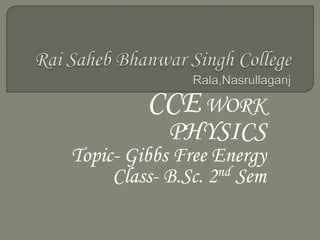GIBBS FREE ENERGY
•Download as PPTX, PDF•
3 likes•7,073 views
GIBBS FREE ENERGY
Report
Share
Report
Share

Recommended
More Related Content
What's hot
What's hot (20)
Similar to GIBBS FREE ENERGY
Similar to GIBBS FREE ENERGY (20)
Plotting of different parameters entropy, enthalpy, gibbs free energy, heat c...

Plotting of different parameters entropy, enthalpy, gibbs free energy, heat c...
Study of interactions among work, energy, and heat. Calorimetry

Study of interactions among work, energy, and heat. Calorimetry
Lets make a little excursion here to see what the thermodynamic co.pdf

Lets make a little excursion here to see what the thermodynamic co.pdf
Thermodynamics and laws of thermodynamics and osmotic or diffusion

Thermodynamics and laws of thermodynamics and osmotic or diffusion
Heat and thermodynamics - III / Dr. Mathivanan Velumani

Heat and thermodynamics - III / Dr. Mathivanan Velumani
More from Rai Saheb Bhanwar Singh College Nasrullaganj
More from Rai Saheb Bhanwar Singh College Nasrullaganj (20)
Recently uploaded
Recently uploaded (20)
Basic Civil Engineering first year Notes- Chapter 4 Building.pptx

Basic Civil Engineering first year Notes- Chapter 4 Building.pptx
Simple, Complex, and Compound Sentences Exercises.pdf

Simple, Complex, and Compound Sentences Exercises.pdf
Python Notes for mca i year students osmania university.docx

Python Notes for mca i year students osmania university.docx
Beyond_Borders_Understanding_Anime_and_Manga_Fandom_A_Comprehensive_Audience_...

Beyond_Borders_Understanding_Anime_and_Manga_Fandom_A_Comprehensive_Audience_...
dusjagr & nano talk on open tools for agriculture research and learning

dusjagr & nano talk on open tools for agriculture research and learning
NO1 Top Black Magic Specialist In Lahore Black magic In Pakistan Kala Ilam Ex...

NO1 Top Black Magic Specialist In Lahore Black magic In Pakistan Kala Ilam Ex...
GIBBS FREE ENERGY
- 1. CCE WORK PHYSICS Topic- Gibbs Free Energy Class- B.Sc. 2nd Sem
- 3. G(p,T)=H-TS Where: U is the internal energy P is the pressure (SI unit: joule) V is the volume (SI unit: m3) T is the temperature (SI unit: kelvin) S is the entropy (SI unit: joule per kelvin) H is the enthalpy (SI unit: joule)
- 4. The expression for the infinitesimal reversible change in the Gibbs Free Energy as a function of its natural variables p and T, for an open system subjected to the operation of external forces Xi, which cause the external parameters of the system ai to change by an amount dai, can be derived as follows from the first law of reversible processes:
- 5. TdS = dU+pdV- summation(nu)idNi+summation(Xidai)+…. d(TS)-SdT = dU+d(pV)-Vdp- summation(nu)idNi+summation(Xidai)+…. d(U-TS+pV) = Vdp-SdT+summation(nu)idNi- summation(Xidai)+…. dG = Vdp-SdT+summation(nu)idNi- summation(Xidai)+….
- 6. where, (nu)i is the chemical potential of the ith chemical component (SI unit: joule per particle or joules per mole) Ni is the number of particles (or no. of moles) composing the ith chemical component
- 7. This is the first form of Gibbs fundamental equation. In the infinitesimal expression, the term involving the chemical potential accounts for changes in Gibbs Free Energy resulting in from influx or outflux of particles. In other words, it holds for an open system. For a closed system, this term may be dropped.
- 8. The temperature dependence of the Gibbs energy for an ideal gas is given by the Gibbs Helmholtz equation and its pressure dependence is given by: G/N = Go/N+kT In P/Po If the volume is known rather than pressure then it becomes: G/N = Go/N+kT In Vo/V Or more conveniently as its chemical potential: G/N = (nu) = (nu)o+kT In P/Po In non-ideal systems,fugacity comes into play.
- 9. The Gibbs Free Energy total differential natural variables may be derived via legendra transforms of the internal energy. dU = TdS – pdV + summation(nu)idNi Because S,V and Ni are extensive variables,Euler’s homogenous function theorem allows easy integration of dU. U =TS – pV + summation(nu)iNi The definition of G from above is G = U + pV - TS Taking the total differential,we have dG =dU + pdV + Vdp – TdS - SdT Replacing dU with the result from the first law gives, dG = TdS – pdV +summation(nu)idNi + pdV + Vdp –TdS –SdT =Vdp – SdT + summation(nu)idNi The natural variables og G are then p,T and {Ni}
- 10. “The greatest amount of mechanical work which can be obtained from a given quantity of a certain substance in a given initial state, without increasing its total volume or allowing heat to pass to or from external bodies except such as at the close of the processes are left in their initial condition.”
- 11. According to second law of thermodynamics,for systems reacting at STP, there is a general natural tendency to achieve a minimum of the Gibbs free energy. A quantitative measure of the favourability of a given reaction at constant temperature and pressure is the change del(G) in Gibbs free energy that is effected by proceeding with the reaction. As a necessary condition for the reaction to occur at constant temperature and pressure, del(G)must be smaller than the non-PV work, which is often equal to zero.
- 12. In traditional use, the term “free” was included in “Gibbs free energy” to mean “available in the form of useful work”. The characterization becomes more precise if we add the qualification that is the energy available for non- volume work. However, an increasing no. of books and journal articles do not include the attachment “free” referring to G as simply “Gibbs energy”. This is the result of 1988 IUPAC meeting to set unified terminologies for the international scientific community, in which the adjective ‘free’ was supposedly banished. This standard, however has not yet been universally adopted.
- 13. Del(G) equals the maximum amount non-PV work that can be performed as a result of the chemical reaction. If the analysis indicated a positive del(G) for the reaction, then energy in the form of electrical or other non-PV work would have to be added to the reacting system for del(G) to be smaller than the non- PV work and make it possible for the reaction to occur.
- 14. THE END
